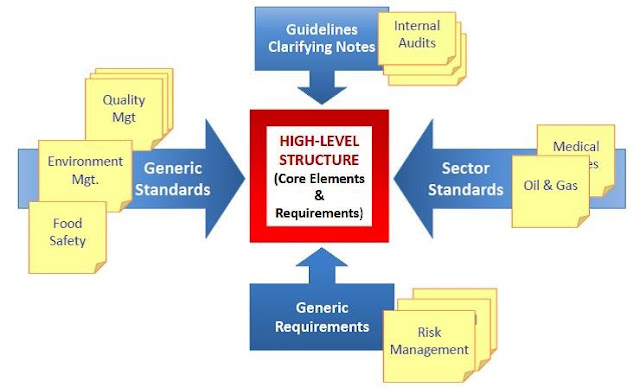ISO 9001
Introduction
ISO 9001 is managed by the International Organization for Standardization (ISO)
in Geneva, Switzerland. ISO is a self-governing membership organization and the
largest developer of voluntary international standards in the world. International
Organization for Standardization’s ISO 9001 series describes standards for a
Quality Management System addressing the principles and processes surrounding
the design, development and delivery of a general product or service. It supports
businesses and organizations to be more effective and improve customer
satisfaction.
A new version
of the standard, ISO 9001:2015, has just been launched, replacing the
previous version ISO 9001:2008 to overcome the challenges that was there
in few decades ago and faced by business organizations.
For example,
the way we do business, often operates with more complex supply chains with the
increasing of globalization. Additionally the expectations and the need of
access to more information from customers and other interested parties to
organization has been increased. ISO 9001 needs to give consideration to these
changes in order to remain relevant.
Differences between ISO 9001:2008 and ISO 9001:2015
- The most obvious change is the new structure of the standard. As other ISO management system standards the ISO 9001:2015 now follows the same global structure and making it easier for anyone using numerous management systems.
- ISO 9001:2015 has ten clauses instead of eight. The following table shows the relationship between the ISO 9001:2008 clauses to those in the new ISO 9001:2015.
|
ISO
9001:2008
|
ISO
9001:2015
|
|
0. Introduction
|
0. Introduction
|
|
1.
Scope
|
1.
Scope
|
|
2.
Normative reference
|
2.
Normative reference
|
|
3.
Terms and definitions
|
3.
Terms and definitions
|
|
4.
Quality management system
|
4.
Context of the organization
|
|
5.
Management responsibility
|
5.
Leadership
|
|
6.
Resource management
|
6.
Planning
|
|
7.
Product realization
|
7.
Support
|
|
8.
Measurement, analysis and improvement
|
8. Operation
|
|
|
9.
Performance evaluation
|
|
|
10. Improvement
|
The first 4
clauses (0-3) of ISO 9001:2015 are largely same as those are in ISO 9001:2008.
There are significant differences between these two versions from the 4th
clause onwards. The last seven clauses are organized according to the PDCA
cycle (Plan, Do, Check, Act).
- Plan – 4th, 5th, 6th and 7th Clauses
- Do – 8th Clause
- Check – 9th Clause
- Act – 10th Clause
- As all standardized management systems ISO 9001:2015 has the unambiguous structure known as ‘High Level Structure (HLS)’ as a result of new arrangement in ten clauses.
- In ISO 9001:2015 puts more focus on input and output. Articles, information and specification that are involved in the production process must be clearly monitored and must be checked which good articles are come out of the production process according to the ISO 9001:2015 version.
- An obvious requirement for risk-based thinking to support and increase the understanding and application of the process approach. Risk analysis is used to decide which challenges are comes into the management of business process and to mitigate those risks.
- Increased leadership requirements and management commitment
According to the ISO 9001:2015
version business process requires more involvement of top managers and business
leaders in handling the quality management system. Therefore it integrates and
brings business process and business strategies together.
The ‘Management Representative’ of
ISO 9001:2008 was a member of the management committee who had the
responsibility and authority for directing the quality management system along
the right lines. ISO 9001:2015 does not mention this aspect any more. The idea
behind the change is that quality is a matter for everyone and for all levels
within the organization.
- Increased emphasis on organizational context
Among other things, as an
organization, you have to take into account the needs and expectations of
interested parties and that you evaluate and deal with internal and external
strategic questions. You have to show that, as an organization, you understand
and respond to the expectations of all the parties concerned.
- More flexibility regarding documentation
No longer requires mandatory
documented processes or a quality manual. The information can be in any format
and come from numerous sources and media. Various forms of evidence or
documentation are therefore possible. There is no longer any mention of
‘records’ neither, but of ‘retaining documented information’.
- Greater emphasis on achieving desired process results to improve customer satisfaction
How can companies transition from
ISO 9001:2008 to ISO 9001:2015?
ABC Company is already ISO 9001 certified, it needs to take the following steps as shown in the below figure in order to comply with ISO 9001:2015
- Baseline measurement
- Perform a standard measurement in the organization. Create a comprehensive overview of the current status of organization’s quality management system and organization’s behavior of business.
- Plan of approach
- Draw up a plan based on the standard measurement. Because of this plan, organization can take the time to make changes and to implement improvements step by step.
- Implementation
- Implement the changes in accordance with the plan of approach. Incorporate measurement points and milestones.
- Auditing and process analysis
- Measure whether the changes have had the desired effect. Measure the input and output of the processes you consider to be important because they are critical or risky, for example.
- Certification
- Have the organization certified according to ISO 9001:2015.
- Communication with interested parties
- Show your interested parties not just the certificate, but also show them the results with pride. Let them see how well your organization manages its processes and continuously improves them.





Comments
Post a Comment